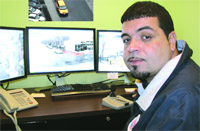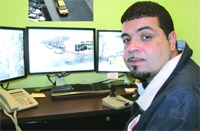
Big-Picture Issues
Surveillance System Brings Crime, Safety Concerns into Focus
Theyve been in place only a few months now, but the cameras positioned in downtown Springfield are already showing enormous promise as a vehicle for making the area safer and more attractive. The surveillance system currently boasts more than 15 cameras, and there will be 25 within a few weeks and 40 by the end of the next year. Theyre capable of picking up license plates from a few hundred yards away, and theyre giving Springfield officials and police some much-needed eyes in the sky.
Chris Castellano zoomed in on a stretch of Harrison Avenue near the Civic Center Parking Garage.
There had been a rather high incidence of motor vehicle break-ins of the so-called smash-and-grab variety in that area, and Castellano, operations manager of the Springfield Business Improvement District (BID), wanted to show BusinessWest exactly where all this was happening.
He did so by manipulating a camera installed atop the back of the TD Banknorth Building that sits on the corner of Main and Harrison now sending images to a command post of sorts at the Springfield Guides offices within that office tower. This is one of about 15 cameras that have been installed in the downtown area, with another 10 to be put in place over the next few months, and a total of 40 by the end of 2009.
With his Nintendo-like joystick, Castellano, staring at a bank of computer screens in the so-called monitoring room, could zero in on that aforementioned area along Harrison Avenue, pan across to other sections of that busy quadrant, and even get in tight enough to read license-plate numbers and identify features on passersby, such as their style of dress and the color of their pants.
And with all that capability, he and others involved in a broad surveillance program involving the downtown and other areas of Springfield hope and expect to be able to use the past tense much more often when it comes to describing crime and patterns of it in the City of Homes.
This was the overall motivation behind a $175,000 state earmark for cameras and monitoring equipment, the first several of which were installed a few months ago, with new additions coming regularly since.
Indeed, as he talked with BusinessWest, Castellano discovered that another camera had been activated since the last time he was in his chair this one a few hundred yards down Harrison Avenue. Perched on a light pole, it provides great views of the corner of Chestnut and Mattoon streets, which has been identified as a trouble spot in some ways.
This is going to be interesting, said Castellano as he maneuvered the camera and developed a feel for its range of motion, noting, as he did so, that the street corner in question and the surrounding area have seen larger-than-desired volumes of loitering and panhandling, much of it in front of a liquor store at the intersection. The new camera should help the Springfield Guides, a small group of individuals who patrol the 26-block area under the auspices of the BID and assist the police with keeping order, to reduce such activities and thus better protect visitors, workers, and residents in the downtown.
A lot of the complaints we get and the reason we put this camera here and put cameras in the positions theyre in involve loitering and people who make others feel unsafe, he explained. With this camera, we can zoom in, and if we see anybody, we send out one of our patrols and ask them to move along. If they refuse to move, we contact the police, and they tell them to move along.
This isnt exactly what would be called serious crime, said Castellano, but it falls under the categories of quality of life and perception of safety, and the surveillance program should improve both.
And when we cut down on those types of things, people will see that downtown is not a bad place to live or work in, he continued, adding that the surveillance program is as much an economic-development tool as it is a public-safety initiative.
If the bad guys dont yet know there are cameras on them its been all over the news, and if they read the press release we sent out, theyd know where the cameras are located, said Castellano they may well find out the hard way.
Its amazing what weve been able to see and do in just a few weeks weve caught some people doing things they wouldnt do if they knew there was a camera on them, he continued, adding that he believes the cameras have helped police identify some wrongdoers, and will undoubtedly contribute to taking many such individuals off the streets, while giving law-abiding individuals more peace of mind.
For this issue, BusinessWest spent some time in the monitoring room to gain an understanding of the new surveillance system and how it should impact some of the big-picture issues in the regions largest city.
Zoom Service
As he clicked through the menu of cameras currently installed, Castellano stopped at the one aimed down Worthington Street by whats called Duryea Park.
This is a fun one, he explained. With this camera we can see all the club action we can see all the petty things kids do when theyre drunk and heading in and out of all the clubs.
Fun was a word Castellano used more than a few times, but this surveillance program is serious business with a hard purpose making a large dent in the twin issues of crime and the perception of same, which have been identified as some of the keys to revitalization of the city.
Such programs have been instituted in several other metropolitan areas, and even some much smaller communities all as part of a broad program funded mostly by the U.S. Department of Homeland Security in the aftermath of the 9/11 attacks. While officials in the Boston suburb of Brookline recently made headlines for threatening to reject cameras amid concern from residents about a surveillance society, hundreds of cities and towns have embraced them.
That list includes New York, which has cameras in several areas of the city, Chicago, Atlanta, and Wilmington, Del. Business-improvement districts have been involved with the surveillance efforts, Castellano explained, and Springfield BID officials checked out several other cities systems to gain insight into their capabilities and performance.
In downtown Atlanta, cameras were installed roughly a year ago, said BID Director Jeff Keck, adding that, according to one account, development officials in that city noted a significant drop in crime over the past six months and the surveillance system has been given some of the credit.
A comprehensive surveillance system has been talked about in Springfield for the better part of a decade, said Castellano, adding that, while cameras had been approved and money earmarked, the cameras were not actually funded by the Legislature until very recently. In fact, lawmakers had to override Gov. Patricks budget veto to bring the first cameras to the downtown in early October.
There are now cameras spread across the 26-block section handled by the BID an area that stretches from East Columbus Avenue to Edward Street, from Frank B. Murray Way to Bliss Street and some locations outside that zone, including two in Mason Square.
The surveillance system is still a work in progress, said Castellano, with some kinks being worked out, new cameras being added regularly, and software upgrades pending that will significantly improve overall performance. In addition, the BID is exploring opportunities with Springfield Technical Community College to create classes that would train individuals to use the technology.
As an example of what this technology can or soon will do, Castellano paused to watch a pedestrian moving past the MassMutual Center. Soon, a software upgrade will enable individuals monitoring images sent from the cameras to essentially click on such an individual and follow their movements all hands-free.
There is a certain Big Brother-like nature to this kind of surveillance that concerns some, Castellano acknowledged, but polls show that a majority of Americans support such activity as a way to reduce crime and keep streets safer.
Frame Work
Running through the scope and capabilities of the system, Castellano said the cameras are perched on buildings and streetlights, and have been strategically placed (with significant input from city police) to help reduce the incidence of crime. Images are monitored from 4 p.m. to 4 a.m. each day.
The cameras have a 360-degree range of motion, are equipped with night-vision technology, and can bring license plates into focus from several hundred feet away. The accompanying software, meanwhile, enables those monitoring the images to zoom in and out, play back any incidents, break them down frame by frame, and review them using slow-motion and freeze-frame technology.
We can see things much better than we could with the naked eye, said Castellano, noting, for example, that a frame-by-frame review of some images from one camera revealed how an individual was able to determine which cars to break into.
He had a scout working ahead of him, checking out the cars, he explained. Thats how he could tell one car was unlocked. We used the tape to see that a guy was using a torch to break into cars; it turned out to be the same guy.
As he focused in on another pedestrian seen in a recording of events captured by a camera at 1648 Main St, near the federal building, Castellano showed how the system could detect such details as a red hooded sweatshirt, brown pants, and sneakers. Sometimes, this is all police need to further an investigation.
Indeed, while most of the cameras have only been in place a few weeks or even a few days, Castellano said its certainly not too early to state conclusively that the surveillance system should help reduce the incidence of crime in Springfield.
The cameras are proving themselves extremely effective in showing us all thats going on and helping to make the streets safer, he explained. Were still working the kinks out; once were at 100%, this system is going to be able to catch everything. Its amazing what it has caught already and sometimes we dont even realize what weve caught.
Castellano was careful not to reveal information that could hinder ongoing police investigations, he did say the cameras have helped achieve what he would term progress in some trouble spots.
These include Stockbridge Street, and specifically the area behind the Community Music School site of several motor-vehicle break-ins and the area by Gridiron Street and the Hippodrome.
Meanwhile, Castellano said he and others who monitor the images are finding their work intriguing and ultimately quite rewarding.
Its work, but I have some fun with it, and my guys have some fun with it, too, he explained. They get really pumped up trying to catch someone committing a crime, and they love working with police; its exciting to them. Were the eyes and ears for the police.
Eyes in the Sky
Returning to the images provided by the camera positioned on Worthington Street, Castellano said that, in addition to the antics of club-goers, those monitoring the images have witnessed a few minor fights, all of which were broken up by police or bouncers.
Overall, he said the cameras have revealed something he pretty much knew already as a BID official and downtown resident that Springfield has crime, but nothing more than most cities its size.
The surveillance system will make this known, he said, and also let residents, workers, and visitors understand that the city is focused on public safety, quality-of-life concerns, and, in general, making downtown a place to be, not a place to avoid.
In other words, big-picture issues.
George OBrien can be reached at[email protected]






